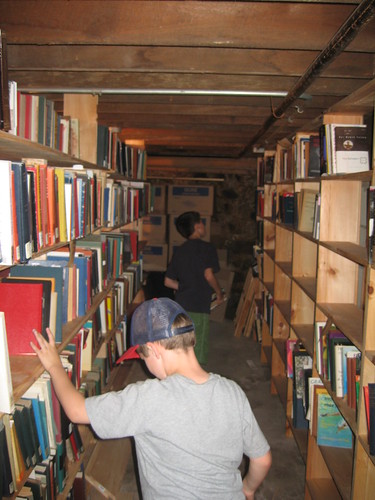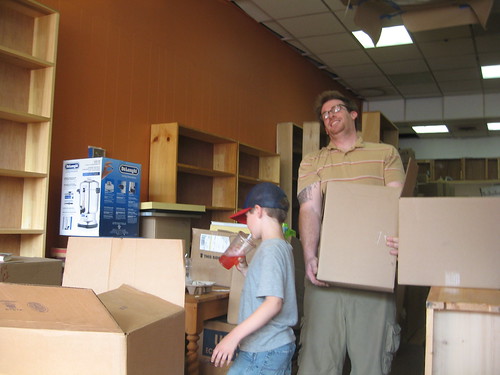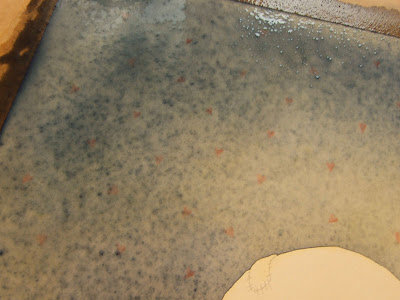It’s funny - when I was packing up our 20,000 books and all of the
associated detritus that collected along with them over the past five
years, I swore that had to be the worst part of the move. Before that,
when I was pulling down pink plywood, plastering over holes, sheet rocking
and painting, I pretty much figured that was the worst part. It should
surprise no one then, given my track record, that the worst part is the
interminable unboxing and reshelving of books. Adding to the
unpleasantness is the fact that we’ve decided to rationalize (that’s a
euphemism for make some vague sense out of) our internet cataloging
system. This brings me, somewhat obliquely, to my first bits of advice:
1 - Make sure your system of arranging books that you sell online makes
sense and is scalable (not in the arranging them in the form of a ziggurat
sense, but in the functions well under large numbers sense) ; it’s going
to be a pain to fix five years down the line
(you’ll notice that much of this “advice” is of the “I climbed a water
tower and fell off and now travel high schools telling kids not to climb
water towers” variety).
2 - Don’t put a box of books in your basement unless you’re pretty sure
you want to carry them back upstairs, load them into a truck and move them
across town. Also, don’t put 200 of these in your basement.
3 - Be organized in your move - stack sections together and in the order
you’d like to use them. I actually thought of this one beforehand, but
I’m constitutionally incapable of this level of organization - if you can
do it though, your present self will owe your past self a debt of
gratitude (as a friend of mine likes to say).
All of which adds up to the fact, some may say obvious fact, that moving
something as heavy as a used bookstore should not be done without the best
of reasons. Ours were complicated - rising rents, static foot traffic
(static at a bad level - the U.S. obsession with growth has made static a
bad word when it could be lovely. Why does no one ever say statically
good?), and a commercial district that has begun to favor restaurants.
Now, I love restaurants as much as the next guy who can’t afford to go to
them very often, but a certain percentage of restaurants in a commercial
district is pretty much a death knell for traditional retail. The hours
are just too different for them to work together - it’s possible all those
mom and pop shops should just be open from 5 PM - 12 PM, who knows. I’ve
worked in too many restaurants though - those hours will really mess with
your head.
So with rents and changing dynamics, it was time to go - luckily we
actually learned a few things since our first opening.
Don’t settle for two many “this should be ok”s when choosing a space. If
you leave yourself enough time to look, you should be able to find the
right space (this goes for opening the first time as well, of course).
Our first shop was a good size but had too many strangely shaped spaces
and quirks that we were paying for - we also were about 200 feet from
where we needed to be and when those pedantic jackasses say that the three
most important concerns in retail are location, location, location,
they’re not JUST being annoying.
Try not to cut too many corners - this can be difficult when working on a
shoestring budget, but try to do things properly or not do them at all.
Half-assing a few things here and there (e.g. buying an area rug to
disguise an ugly floor instead of replacing the floor) is appropriate,
but, at least for me, these half measures get a grip on you after a while
and start being too obvious - eventually the enterprise takes on the dull
sheen of half-assedness. If you think the color of your walls is ok,
paint them the color you really want, you won’t regret it (joyfully, the
pink walls at our new store left me no half option on this one).
And oh yeah, lift with your legs.
Here’s a few pictures as order begins to emerge from the chaos:

Aisle one of internet books in the basement. We enlisted the help of
local street urchins to shelve the books.

Aisle 2. Anyone looking to purchase 500 slightly used boxes?

Street urchins are also useful for book cataloging.

Not so much for the hauling of heavy boxes as my brother apparently notices.

This last is from our moving fundraiser. This, which I must admit I was
skeptical about, turned out great. We had a bunch of silent auctions,
collected donated items from local friendly businesses (and gave them
great advertising - or tried), local urchins ran a hot dog cart, and we
had a keg of beer and a band (pictured - if you have kids at your party,
get a guy with a pink suit, they went nuts). All of our intensive studies
show that customers purchase at least 30% more when drinking.
– Pazzo Books 4268 Washington St. Roslindale, MA 02131 pazzobooks.com 617-323-2919
Add a Comment








Hi Gretel, Thanks for sharing your process and those fantastic close-up photos! I love the muted colours you use, and envy your ability to know which colour does what. I know this comes with practice and experience - I just need to buckle down! Thanks for visiting earlier today. :O)
Thank you for showing this process, it is very helpful. I am afraid to try washes with watercolor because it is so unpredictable but this makes me want to give it a try. =) Hmm.. now I have to go find some tape and a board...
This is lovely to watch - I can almost taste the tea and sense the apprehension as the perfect drying point gets nearer! Thanks for sharing this, G!
Hope you are feeling alot better after your poorliness, sweetie, and sorry for being so crap at posting lately....
x
There is something magical about a wash, waiting to see how it will turn out - I love it! What paper are you using - I like the creamy shade.
Thank you artistic ladies! Jess, I used to be not-so-good with watercolour, one day I'll post some of my earlier efforts!
Parrish, watercolour is like an excitable dog, if you learn to make it walk to heel it will do anything for you, otherwise it's all over the park! Give it another go, go on!
Viggy, wondered where you had gotten to!
Caroline, it's just Arches HP (140lb I think) but I always start with a (very) thin yellow wash on all my paintings, hence the creamy effect.
This seems such a wondrous process, and, besides the talent, it takes so much knowledge and patience. Thank you for sharing this. I am awed.
Yes the effects are magical. you must be very patient.
but worth all the effort.
Re hot choc at the Majorell Gradens - I think we were just lucky - some Moroccans can make you wait FOR EVER!!!
Thanks for sharing the painting process G, its really interesting to see how others work.
Just had a look at your Marrakesh link, such an interesting place, one funny memory I have is a whole market stall of second hand false teeth!
P.x
Thanks for showing this aspect of your process, Gretel. It looks like magic. Your work is so subtle and elegant. I've been inspired by you and Lisbeth Zweger to try a more delicate approach on a painting. Have you using a masking fluid here to reserve some areas? Also I just recently picked up some Aqqua pasto, a watercolour retarder, have you tried this? Any thoughts?
Ooh no, never heard of it - (goes off to Google) oh, I see, it thickens paint...no, I like my paint thin! I rarely use masking fluid, I put a clean sheet of water down onto the area I'm about to wash into, and then work very quickly. If it is a very big wash (A2) I will add ox gall, which helps with the flow, but normally it's just speed, paint and water.
It's an extender, and I've found that it's more effective for gouache inmy own work, if I'm doing clouds with lots of blending, say. Though I rarely use it, I was more curious if it was in your arsenal of tools. I have never used Ox Gall and don't know much about it, it's a wetting agent and it reduces water tension? What does that mean in practical terms? Maybe I should buy some and just try it out.
Whoops, that last comment was me, Eric....
Well, it just seems to stop the wash drying out so quickly, and makes it less likely to make tidelines - I don't know precisely how it works; it's the only 'extra' I use, apart from once in a blue moon I might use gum arabic to bumph up a little area of colour. I find it useful when I have a very big expanse of flat wash to do, which will not have much added to it, but my work tends to be emptier of content than yours (probably because I am lazy...), so you probably wouldn't have a use for it. :)
Hello Aunty Gretel!
Happy new year!
I'm taking a break from "nesting" to say "bonjour".
I miss working in watercolour, there's something magical about it and you have it nailed, IMHO :0)
Erica
xxx
I have always wanted to paint watercolours...I once had a glorious hour long lesson over looking the habour on the Isles of Scilly (a birthday present from my aunt). Now I have time on my hands I am going to have another bash.
Thanks for showing us this, any more help would be most welcome :-)
Take care,
Alison x
Hello and thank you for being so generous with the watercolor lessons.
I agree that the photos are terrific, and really do "show" what you are "telling."
Right now, I have an hour to get ready and to travel to work, but what I would like to do right now is get out the watercolors, brushes and paper! Tomorrow's a day off, so I hope to hold on to this inspiration.
Cheers!
I love watercolor and all the work up on your blog!!! cheers!
I'm sure I left a comment before - am I going doolally, Gretel?!! Beautiful work, fab to see the different stages :)
Whew!
I'm glad I am sitting down!
I feel like I have just witnessed a Magic trick!
Just Amazing! And I love that you don't follow the "rules", me too!
Sandra Evertson
Thanks so much Gretel for letting us in on a few trade secrets on how you do your amazing work. This is such an informative and inspiring post. Of course, we will all rush out and try it and discover how very difficult it is to get just the right result. But ... with time ... and trial and error. Hope you are well!
I always admire people greatly who can make paper, paint and brush into a picture!
I love you cone people too!
And there I was thinking it was all so simple............There's an art to this artistic thingy !
I'm well impressed PG
I put up a process post, so now we can compare notes.